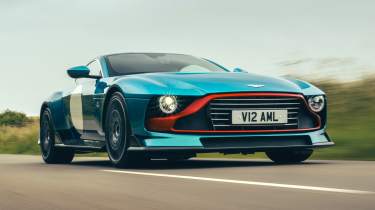Aston Martin Valour review – a £1.5m V12 Aston you could drive daily
Inspired by a brake‑eating 1970s Le Mans racer and packing a 705bhp twin‑turbo V12 and a manual transmission, the Valour is an Aston Martin for modern times but with bags of old‑school appeal
It’s easy to dismiss this car as an irrelevance. Ultra-rare. Ultra-expensive. Based upon old-generation hardware. And sold out: 110 Aston Martin Valours are being made (to mark 110 years of Aston Martin in 2023), and all are spoken for. Each is being built in a specification unique to its owner and the price will vary accordingly, but assume somewhere in the region of £1.5m depending on spec, including taxes.
Since it exists in the unobtainosphere, perhaps it doesn’t really matter what it feels like and drives like. But we’re about to find out nevertheless. Today we’re kidnapping this particular Valour from the Gaydon factory, and hanging on to the key for as long as possible.
Meeting it for the first time, it’s quite a thing to behold. Some cars are different in person from in pictures and the Valour is one of them. It’s a more compelling object to behold in three dimensions. Not pretty per se, but that’s not the point: this is intended to be a bruiser of a car, taking its cues from the muscular DBS and V8 Vantage models of the ’60s, ’70s and ’80s. And, in particular, RHAM/1, aka ‘Muncher’, a highly modified DBS V8 that raced at Le Mans twice, and so called for its appetite for munching through components – brakes especially – as well as gobbling up the Mulsanne Straight.
More reviews
And if the Valour looks a little familiar for more recent reasons, that’s because it’s also inspired by 2020’s Aston Martin Victor: the very special one-off built around a One‑77 chassis and Vulcan components, with an 836bhp V12 engine, a manual gearbox and a similar Muncher-inspired design (see evo 286 for the drive story). The Valour isn’t built on a One-77 donor but rather a development of the Vantage platform, albeit with some parts in common with the most recent DBS to accommodate the V12.
The 110-off Valour is a mass-production car by the standards of the unique, coachbuilt Victor, but its low-volume, high-price remit means Aston Martin’s design team have been able to achieve remarkable shapes with its carbonfibre bodywork – and almost limitless customisation options. This car’s lustrous deep-blue paint, the red band around its nose and race number roundels have been specced by its owner, along with the woollen tweed upholstery for the rooflining and carbon seats (a nod to the similar fabric used on the DBR1 racer’s seats in the 1950s) and the walnut top to the gearlever (buyers can also spec titanium, aluminium or carbonfibre).
Yes, gearlever: as with the Victor, this is a manual. The fact Aston Martin has built a manual-gearbox, V12-engined car in 2024 is something to celebrate, tempered only by the fact that we’re in an age where such a car must cost £1.5m and be built in ultra-low numbers to be viable. But, yes, the Valour has three pedals and a lever, slotting six forward gears via an exposed gate to celebrate its mechanical nature. The gearbox has been developed with supplier Graziano, while the 5.2-litre, twin-turbo engine is related to that found in the now-retired Aston Martin V12 Vantage and DBS 770 Ultimate. In this car, its power and torque have been turned up from the Vantage but down from the DBS to a not-exactly-paltry 705bhp and 555lb ft, so as not to overburden the manual transmission, which runs through a transaxle arrangement with a mechanical limited-slip differential rather than the more sophisticated e-diff fitted to the latest Vantage.
Pulling away, the first thing that strikes you is how light both the clutch pedal and the gearchange are. Given the car’s muscular appearance, I was expecting to perhaps need two feet for the clutch pedal and two hands for the gearlever, but it’s featherweight in action, and smooth too. This is an easier car to pull away in than many family hatchbacks.
And as it turns out, easy to drive in general, wide dimensions (and left-hand-drive blind spots in this particular car) notwithstanding. Nosing out of the Gaydon gates into Warwickshire traffic, it feels strange seeing regular road furniture and Qashqais and Focuses alongside; the Valour looks so outlandish it’s as if it has beamed down from another planet. But it’s an easygoing car to cover real-world ground in. The engine is smooth and tractable, the control weights free and easy, forward visibility perfectly decent. Rear visibility less so, since there is no rear screen: the tailgate is an all-carbon, no-glass affair. The main mirror can be toggled to a digital display linked to a rear-view camera, though like many digital mirror displays, it’s a little disconcerting at first as the frame rate never quite feels in tempo with real life. The display cuts out a few times during our drive, too. Happily, the door mirrors are perfectly useable, and there’s a separate reversing camera display on the infotainment screen, which works nicely and is very welcome when reversing someone else’s £1.5m collector’s piece.
Negotiating traffic while acclimatising to the Valour is the perfect opportunity to fully drink in its interior. The quality is lovely: the door inners are bespoke with smart, smooth carbonfibre surfaces and cold-to-the-touch metal forms that double as door handles and rests. You tug a neat, smart-looking leather pull to release the door catch, and a similar one to slide the seat forward and back. The carbon-shell seats fitted to this car are the same as those available as an option on the new Vantage (though the tweed trim isn’t) but the majority of the interior is from the previous-generation 2018-on Vantage: same dashboard, same squircle-shaped steering wheel and lots of buttons on the centre console. Not that the latter is a bad thing in 2024.
Downsides? Your right elbow (in this left-hand-drive car) naturally rests on a lovely-looking bit of carbon trim that flexes and makes an annoying tapping sound against the console below, and the engine start button is just in front of the gear gate and surrounded by an enormous piece of trim which, if you’re not careful, you can painfully trap your fingers against when putting the lever into reverse gear. And being based on the old Vantage cockpit means it incorporates the old, Mercedes-sourced infotainment system, which looks dated and is famously clunky to operate. That said, to quibble about infotainment in a car such as this feels like missing the point slightly.
It’s a front-engined, 700bhp-plus V12 supercar with a manual gearbox, so let’s find some quiet roads and see what it feels like away from traffic and let off its leash a little. The ride quality at low speeds is very smooth and, happily, that’s the case when you up the pace too, even on lumpy, uneven back-roads. Springs, dampers, anti-roll bars and geometry are all unique to the Valour. The adaptive dampers have three modes: Sport, Sport+ and Track, toggled from the steering wheel. As with the rest of the driving experience, the damping is more relaxed than I’d expected given the Valour’s extreme appearance. You might feel a bit too much body movement when pressing on in Sport, but Sport+ brings more control without ruining the ride. In fact, even in much firmer Track the ride is rarely overly crashy or unsettled (on these mostly smooth roads, at least). But composure and lateral grip during cornering is impressive: this is a sticky car. With strong traction too, although our test is on an admittedly warm, dry day. The Valour wears the same AML-spec Michelin Pilot Sport S 5 tyres as the latest Vantage, incidentally.
Aston has stiffened the structure taken from the earlier-gen Vantage with a number of additional bracing elements, and on the basis of this drive the work has paid off. ‘We learned a lot of lessons from the V12 Vantage, in how to stiffen up the front of the platform for dynamic benefits,’ explains Simon Newton, Aston Martin’s director of vehicle performance. ‘That car was tuned quite aggressively, but the detail and engineering changes to the body also gave us a great platform for refinement.’
The Valour is not a light car at the best part of 1800kg. Nor, despite the lift-cutting spoilers, diffuser and aero surfaces incorporated into its design, is it a track-ready car – that’s reserved for the Fernando Alonso co-developed Valiant version. What it feels like is a smooth, easy-going GT, with a lot of grip and confidence-inspiringly balanced handling.
‘Clearly the inspiration for Valour is somewhat retro, and the driving experience in older cars is less over-controlled than in some modern sports cars,’ Newton says, ‘so it needs to breathe, to roll a little bit, and to be consistent in its control weights.’
The power steering has a similar relatively light, well-damped feel to the clutch pedal and gearshift. The gearchange has quite a broad gate and a relatively long throw, but the spring loading is helpful and it’s as user-friendly at speed as it is in traffic. With a light, nicely damped movement and the engine’s revs rising and falling smoothly, it’s barely any more taxing than driving an auto – and far more enjoyable. It’s not a stone-cold-classic, for-the-ages manual shift, but it is beautifully resolved. The length, weight and throw of the milled-from-billet shifter handset have all been painstakingly balanced. There’s no autoblip rev-matching function for downshifts, but whether you heel-and-toe or not, smooth downshifts are a cinch. Carbon-ceramic brakes are standard, and although they’re occasionally a little abrupt at the first touch of the pedal, they’re nice and easy to modulate beyond that.
As per the damping, you can also ramp through three modes for the engine map. Since the transmission’s gearing is relatively long, it never quite feels as mind-scramblingly fast as you might expect of a 700bhp-plus car. But it’s certainly not slow. It doesn’t feel overly turbocharged either. Although there’s a little lag below 2000rpm or so, it feels flexible and linear all the way to the red line – if you can find the space.
You might wish it were a little bit louder, inside the car at least. Photographer Aston (Parrott) reports that the Aston (Martin) Valour sounds fantastic from the outside, its 12 cylinders borne on the breeze while I’m heading to a turn-around spot between shots. And, to my eternal horror, I’ll later discover that its triple-exit exhausts are loud enough on start-up to make a small child burst into tears when I awaken the engine just as a young family are walking past my parking space. But from the inside the V12 isn’t quite as vocal; it makes a lovely sound but more of a distant, muted bellow than the living, beating, snarling heart the Valour’s appearance suggests. The exhaust is made from stainless steel that’s less than 1mm thick, so it’s no wonder it packs a punch on the outside. Yet very little road noise makes it through to the cabin; it’s a remarkably refined car.
Perhaps the one thing missing from the driving experience is a little more drama in general, to match the sense of theatre and occasion in the Valour’s design and spec. It’s almost a little too refined for its own good: a little more noise, a little more heft to the controls and a little more feedback through the seat of your pants are the only things, subjectively, that are missing. It’s why Aston Martin has created the Valiant, a more track-focused but still road-legal evolution of the Valour, with more aero and a racier suspension set-up, limited to 38 cars. It might seem an odd concept, but having spent the day getting under the skin of the surprisingly easy-going Valour, a more hardcore version actually does make sense.
But an unlikely facet of the Valour’s singular appeal is that you really could drive this concept-car-styled, £1.5m creation every day if you wished: the gearbox is easy as pie, refinement is genuinely excellent and it even has a decent-sized boot similar to that of a regular Vantage beneath the carbon tailgate.
Parking up back at Aston HQ, there’s time to walk around the car and take in the design one more time. I particularly love the ducktail rear, the full-width aluminium trim below (milled from a solid billet), the Valkyrie-style LED lights jutting from the aluminium like shards of glass, and the way your eye follows the creases over the rear haunches. Valour looks like a concept car, but has the quality and refinement of a mass production model rather than a 110-off special. Which goes at least some way towards explaining that price. The details have been sweated over, and it’s a car with unexpected depths – in its design, in its engineering and in the way it drives.
The only nagging doubt is that I think I’d have had more fun in the new, £165,000 regular Vantage, which is a more eager and responsive car, although I’d have missed out on a manual shift. But to view the Valour as a car to compare with others is to do it a disservice. It is its own entity, and something quite special. It’s not where my own (very much hypothetical) £1.5m would go, but that’s beside the point: as a demonstration of what Aston Martin’s designers and engineers can do, as a celebration of the qualities that make the brand special, and as a great car in its own right, it’s a compelling creation.
You can’t help but hope that some of its qualities could be applied to a higher-volume, lower-price model in the future. In particular, it would be nice to have the option of the latest Vantage with three pedals and a lever. And if they can’t be, then the thought of more ultra-rare specials like this being created in the future is still enticing; it works for Ferrari, after all. Is this car an irrelevance? In the grand scheme of things, maybe. But it’s a captivating one.










